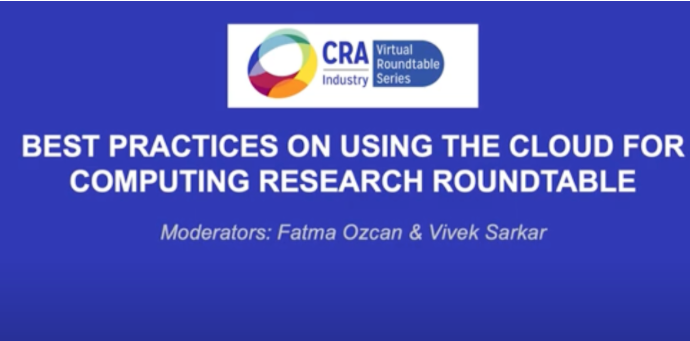 In July 2021, the Computing Research Association’s (CRA) newly formed Industry Committee (CRA-I) launched a series of 75-minute virtual roundtables to initiate discussion on the various areas of interest of CRA-I’s computing research industry partners. The mission of CRA-I is to convene industry partners on computing research topics of mutual interest and connect those partners with CRA’s academic and government constituents for mutual benefit and improved societal outcomes.
In July 2021, the Computing Research Association’s (CRA) newly formed Industry Committee (CRA-I) launched a series of 75-minute virtual roundtables to initiate discussion on the various areas of interest of CRA-I’s computing research industry partners. The mission of CRA-I is to convene industry partners on computing research topics of mutual interest and connect those partners with CRA’s academic and government constituents for mutual benefit and improved societal outcomes.
In September 2021, CRA-I held its second roundtable focused on Best Practices on using the Cloud for Computing Research. The purpose of this roundtable was to discuss best practices and the resulting synergistic opportunities across industry, academia, and government. See a video of the roundtable here. The session was moderated by two members of the CRA-I steering committee: Fatma Ozcan (Google) and CRA-I Co-Chair Vivek Sarkar (Georgia Institute of Technology). The panelists were David Culler (Google), Ed Lazowska (University of Washington), Margaret Martonosi (National Science Foundation), Giovanni Pacifici (IBM Research), and Raghu Ramakrishnan (Microsoft).
Overwhelmingly, the panelists agreed that using the commercial cloud for computing research makes you, as Pacifici put it, “more productive, gives you access to the latest technology, and provides agility.” Lazowska remarked that “nothing that we can build ourselves will have the scalability, shareability, and the rich software and hardware infrastructure that the commercial cloud offers.” Using the commercial cloud for research across academia and government presents a unique opportunity for collaboration and change.
While there are no downsides to using the cloud for computing research, there are some key barriers to overcome. The panel went on to agree that the commercial cloud needs to be more accessible so that it is more available for a wide spectrum of users – as Ramakrishnan said, “all the way from Computer Science (CS) 101 to researchers rethinking telecommunications.” It is becoming more open, but this needs to continue to allow for better portability and better consistency than what we have today. This problem is particularly apparent in CS education. Lazowska remarked that “other fields are much more active at using the cloud than CS…we are not just a backwater compared to industry, we are a backwater compared to other disciplines, which is causing [CS] to be out of step in the 21st century.” Culler agreed that we need to “raise in some sense the technical IQ of our own students throughout and that begins with the faculty actually waking up to the state of the art that we have today.” Martonosi commented that “everyone needs nimble access to scalable resources and our education of our students should align with what they are going to actually experience in the outside world…there is a lot more here than our community makes vibrant use of.”
This nimble access is, in part, being addressed by the National Science Foundation funded CloudBank, a cloud access entity that helps the computer science community access and use public clouds for research and education by delivering a set of managed services designed to simplify access to public clouds. The San Diego Supercomputer Center and Information Technology Services Division at the University of California, San Diego, the eScience Institute at the University of Washington, and the University of California, Berkeley’s Division of Data Science have developed and now operate CloudBank. “CloudBank is an intermediary that helps researchers budget for and access commercial cloud resources. There are no indirect costs on those resources. You can budget it into your CISE core proposals,” explained Martonosi. There was also discussion of the fact that campus supercomputer centers will continue to play an essential role with their expertise in using computing resources for research.
It is clear that the future of computing research is in the cloud, but getting there and sharing its potential with students and the computing research community broadly is challenging. The CRA-I steering committee is eager to continue the momentum from this roundtable and is planning a hybrid workshop to be held March 21-22, 2022 with both remote attendees and an in-person hub in Washington, DC at CRA’s headquarters (1828 L Street, NW, Suite 800, Washington, DC 20036-4632). If you are interested in attending either virtually or in-person in DC, please save the date and let us know here, and feel free to forward the information to interested parties. We will be reaching out to those who express interest in the next few months with more details, including a formal registration form.









